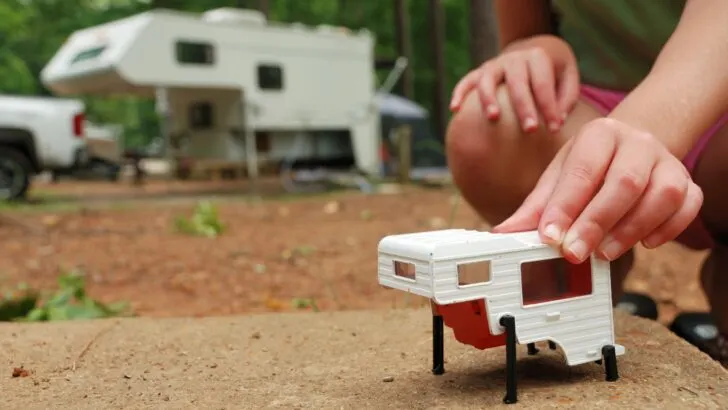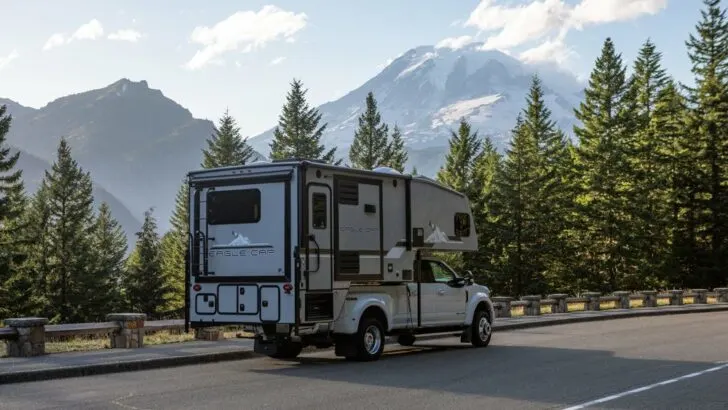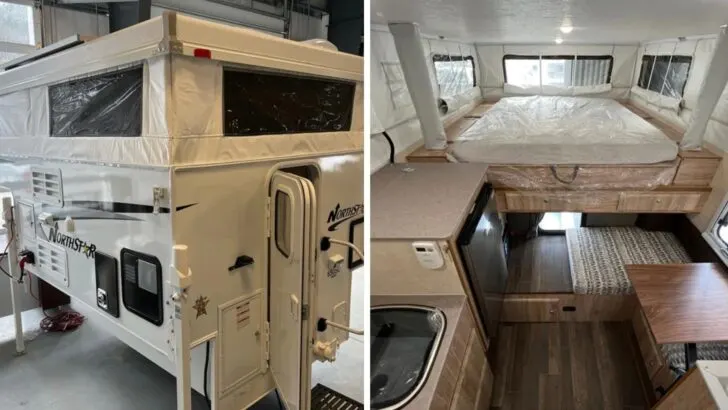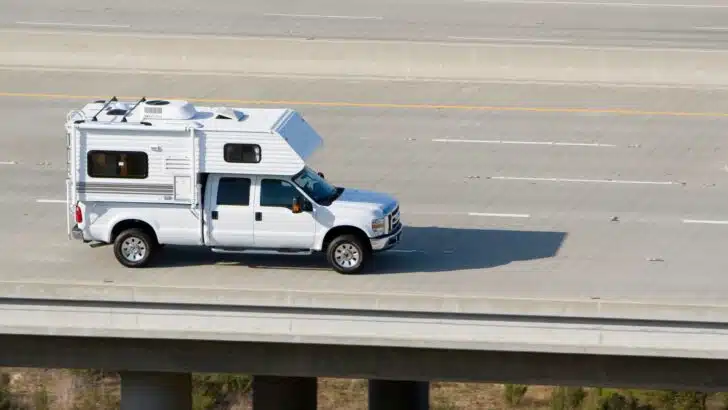What is a slide-in camper? Is it the same thing as a truck bed camper or truck camper? Are there variations on the slide-in/truck camper theme or are they all the same?
Truck campers, or “turtles” as some people call them, are becoming increasingly popular for many reasons. Today we’re looking at campers for trucks and hopefully clearing up a little confusion along the way.
What Is a Slide-In Camper?
A slide-in camper is a type of truck camper, meaning that it’s a camper that’s carried by a pickup truck. But the camper isn’t towed as a truck would tow a travel trailer. Instead, a slide-in camper (and any type of truck camper) sits right in the bed of the pickup.
Throughout the USA and Canada, you’ll hear people refer to truck campers as slide-in campers, pickup campers, cab-over campers, and truck bed campers. In Europe, they generally call them “demountable campers” and that term is key to most descriptions of a truck camper.
Truck campers, slide-in campers, pickup campers, etc., all share the feature of being able to be mounted to and demounted from the pickup truck.
So, for example, you can use your pickup truck all week for various purposes like commuting, carrying lumber, hauling brush, etc. (You can even use the truck as a camping vehicle as described in our post on truck bed camping.)
But when the weekend arrives, you can mount your slide-in camper/truck bed camper onto the pickup, and head just about anywhere, including many remote off-road locations depending on the truck you have. In other words, your camper can go anywhere your truck can go.
Once at your campsite, you can demount the camper, separating it from the truck, set it up on the four camper jacks (or “landing gear”) at each corner, and use your truck independently for exploring (with better fuel economy and easier drivability).

In the background is a full-size truck camper standing independently on its four jacks. In the foreground, a child’s toy illustrates how the legs (camper jacks) work to support the camper independently, without the truck.
No matter what you call it, a slide-in camper/truck bed camper/truck camper/cab-over camper/pickup camper gets mounted in the bed of a pickup truck to create a rig with all or most of the amenities of a full-size RV.
Depending on the camper model, larger slide-in truck campers can even have 1-3 slide-outs to expand the living space once you’ve arrived at your campsite. These require being carried by a heavy-duty truck, however. More on that in a minute.
Are There Different Types of Slide-In/Truck Bed Campers?
There are a couple of different types of campers that sit on the bed of a pickup truck, making it possible to carry your home on your back, turtle-style. Some truck camper manufacturers produce both types, while others specialize in just one or the other. There are pros and cons to each, but the choice between the two really depends on the type of RV you want and the type of traveling you’ll be doing.
Hard-Sided Truck Camper
A hard-sided slide-in camper/truck bed camper generally has either aluminum-skinned walls with wood or aluminum studs. Or they may be made of bonded fiberglass, just as you might see on a motorhome or towable RV.
There are some truck camper manufacturers that make a two-piece solid fiberglass shell for their campers. These hard-sided slide-in truck campers generally use either fiberglass batting or foam insulation throughout the camper.
All structural parts of a hard-sided camper – front, back, sides, and roof – are hard surfaces.

This hard-sided slide-in model is an Eagle Cap camper from Adventurer Manufacturing and is among the largest truck campers ever sold. But they stopped making them in 2022. (Photo source: Adventurer Manufacturing)
Hard-sided truck campers are capable of having slide-outs. Some even have full kitchens and large dry baths. (See “What Is a Dry Bath In a Camper?” for more on dry baths vs wet baths.)
Pop-Up Truck Camper
Most pop-up slide-in truck campers have soft walls that are collapsed for driving and expand upward (pop up) once you’ve reached your campsite.

This fully self-contained soft-sided pop-up truck camper from Northstar is appropriate for ultra-short and short-bed trucks. (Photo source: Northstar Campers)
It’s also possible for a pop-up truck camper to have telescoping hard sides. An example of this type of pop-up is the 6’5″ Cabover Camper from Alaskan. This popup truck camper uses no canvas at all, (so it’s suitable for camping in bear country). Instead, it has a solid wall design that raises and lowers in a telescoping manner.
Like fully upright hard-sided campers, pop-up truck campers can have all of the amenities found in motorhomes and travel trailers, including showers, kitchens with major appliances, dining areas with booth seating, and sleeping areas with queen-size beds.
Pop-up truck campers most often tend to have wet baths, but so do many hard-sided truck campers. (For more information, see our post on the RV wet bath.)
To get an idea of how pop-up truck campers work and how they look once they’re popped up, (including the Alaskan we mentioned above), see our post on 11 great pop-up truck campers.
Both hard-sided and pop-up truck campers have in common the fact that they’re all able to be loaded and unloaded (mounted and demounted) from the bed of a pickup truck.
If you’re curious as to how a truck camper gets loaded and unloaded from a pickup truck, take a look at this YouTube video from our friends Tom & Cait of Mortons On the Move:
What Size Truck Do I Need For a Truck Camper?
There are truck campers made for most size pickup trucks, but the truck you’ll need depends on the size and weight of the camper you intend to carry. A truck/camper combination not only needs to fit together properly but also needs to be payload compatible. So, while truck campers are made for nearly every truck size and payload capacity, the two need to match up. This is critical to safely handling the truck/camper combination.
Whether you need a half-ton, three-quarter-ton, or one-ton truck will depend on the camper’s gross weight (not dry weight), including all gear and any optional equipment you install. Everything needs to be considered, including how large and full your holding tanks are as you travel, and the weight of your passengers.
Some truck campers must be carried by a large long-bed dually truck, while others can be accommodated by a half-ton truck with a 6-foot bed. Safety is the most important consideration, and everything, including the center of gravity, needs to be considered when pairing a truck and camper.

The bulk of a truck camper’s weight should rest on or in front of the truck’s rear axle. This will place the center of gravity in the front-center portion of the truck bed.
When considering the purchase of a pop-up truck camper, the most important thing you’ll need to know is the payload rating of your pickup truck.
Can You Leave a Truck Camper On the Truck All the Time?
You can leave your slide-in/truck bed camper on your truck while you’re driving, camping, and living in it. You can also demount the camper from the truck and live in the camper portion while you leave the truck free for independent use. Either way, the camper won’t be damaged if you properly set up the jacks and level it when it’s demounted from the truck.
If you want to leave a camper on a truck bed indefinitely, that’s a different question though the answer is similar.
You can leave your camper on your truck for indefinite periods. Just keep in mind that, like any motor vehicle, a truck should be driven from time to time. It’s not good for any vehicle to sit unused for months on end. We exercise our motorhome (and generator and air conditioners) at least once a month whenever we’re parked in one spot for an extended period.
Is Your RV a Slide-In/Truck Bed Camper?
If your rig is a truck camper, we’d love to hear what you consider to be the pros and cons of this type of RV. How do you like it? How does it drive? Does the top-heavy nature of a hard-sided truck camper cause a white-knuckle situation on the highway? How’s your fuel economy? Share your experience with your truck/camper combination in the comments section below.
Free RVing Tips, Tricks, Reviews, Giveaways & More
Subscribe to our daily newsletter! We’ve been full-time RVers for 20 years (!) and share everything we’ve learned about RVing in our daily blog posts. Join our online community to receive a wealth of great RVing knowledge delivered right to your inbox.
Whether this is your first time on the road or you’re a seasoned full-timer, you’ll love the wide range of RVing topics we cover. Don’t miss a single article or any of our famous RV gear Giveaways — Subscribe today!


mjh
Saturday 1st of July 2023
We've had 3 slide-in popup campers since 1998, all riding in Toyota Tacomas with boosted suspensions. Wherever we go, we've ready to pull over, pop up, and enjoy -- disbursed camping or campground. Highly recommended. That said, nearing 70 years old, I'm less enthusiastic about climbing up into the bed or going outside for a bathroom.
TheRVgeeks
Saturday 1st of July 2023
Thanks for sharing your experience! And yes... we know what you mean about having the bathroom conveniently placed INSIDE!